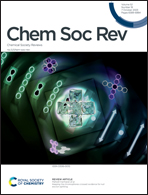Smart organic materials based on macrocycle hosts†
Abstract
Innovative design of smart organic materials is of great importance for the advancement of modern technology. Macrocycle hosts, possessing cyclic skeletons, intrinsic cavities, and specific guest binding properties, have demonstrated pronounced potential for the elaborate fabrication of a variety of functional organic materials with smart stimuli-responsive characteristics. In this tutorial review, we outline the current development of smart organic materials based on macrocycle hosts as key building blocks, focusing on the design principles and functional mechanisms of the tailored systems. Three main types of macrocycle-based smart organic materials are exemplified as follows according to the distinct forms of construction patterns: (1) supramolecular polymeric materials and nanoassemblies; (2) adaptive molecular crystals; (3) smart porous organic materials. The responsive performances of macrocycle-containing smart materials in versatile aspects, including mechanically adaptive polymers, soft optoelectronic devices, data encryption, drug delivery systems, artificial transmembrane channels, crystalline-state gas adsorption/separation, and fluorescence sensing, are illustrated by discussing the representative studies as paradigms, where the roles of macrocycles in these systems are highlighted. We also provide in the conclusion part the perspectives and remaining challenges in this burgeoning field.

- This article is part of the themed collection: Supramolecular Chemistry


 Please wait while we load your content...
Please wait while we load your content...